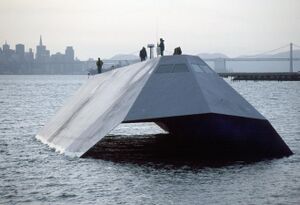Engineering:Sea Shadow (IX-529)
 Sea Shadow sailing through Californian waters near San Francisco in March 1999
| |
| History | |
|---|---|
| Name: | Sea Shadow |
| Awarded: | 22 October 1982 |
| Builder: | Lockheed Shipbuilding and Construction Company |
| Completed: | 1984 |
| Acquired: | 1 March 1985 |
| Out of service: | September 2006 |
| Struck: | September 2006 |
| Fate: | Scrapped in 2012 |
| General characteristics | |
| Type: | Stealth ship |
| Displacement: | 563 long tons (572 t) |
| Length: | 164 ft (50 m) |
| Beam: | 68 ft (21 m) |
| Draft: | 15 ft (4.6 m) |
| Propulsion: | Diesel-electric |
| Speed: | 14.2 knots (26.3 km/h; 16.3 mph) |
| Complement: | 4 |
| Armament: | None |
Sea Shadow (IX-529) was an experimental stealth ship built by Lockheed for the United States Navy to determine how a low radar profile might be achieved and to test high stability hull configurations that have been used in oceanographic ships.
Development
Sea Shadow was built in 1984 to examine the application of stealth technology on naval vessels, and was used in secret until a public debut in 1993. In addition, the ship was designed to test the use of automation to reduce crew size. The ship was created by the Defense Advanced Research Projects Agency (DARPA), the U.S. Navy and Lockheed. Sea Shadow was developed and built at Lockheed's Redwood City, California facility, inside the Hughes Mining Barge (HMB-1), which functioned as a floating drydock during construction and testing.[1]
History
Sea Shadow had a SWATH (small-waterplane-area twin hull) design. Below the water were submerged twin hulls, each with a propeller, aft stabilizer, and inboard hydrofoil. The portion of the ship above water was connected to the hulls via the two angled struts. The SWATH design helped the ship remain stable in rough water up to sea state 6 (wave height of 18 feet (5.5 m) or "very rough" sea). The shape of the superstructure was sometimes compared to the casemate of the ironclad ram CSS Virginia of the American Civil War.[1]
Sea Shadow had 12 bunks, one small microwave oven, a refrigerator and table. It was not intended to be mission-capable and was never commissioned, although it is listed in the Naval Vessel Register.
Sea Shadow was revealed to the public in 1993, and was housed at the San Diego Naval Station until September 2006, when it was relocated with the Hughes Mining Barge to the Suisun Bay Reserve Fleet in Benicia, California. Until 2006, Sea Shadow and the HMB-1 were maintained and operated by Lockheed Martin for the US Navy. The vessels were available for donation to a maritime museum.[1]
The USNS Impeccable and Victorious ocean surveillance ships have inherited the stabilizer and canard method to help perform their stability-sensitive intelligence collection missions.[1]
In 2006, the U.S. Navy tried to sell Sea Shadow to the highest bidder;[1][2] after the initial offering met with a lack of interest, it was listed for dismantling sale on gsaauctions.gov.[3] The US government mandated that the buyer not sail the ship and be required to scrap it. The ship was finally sold in 2012.[4][5] Sea Shadow was dismantled in 2012 by Bay Ship & Yacht Company.[6]
In popular culture
In the 1997 James Bond film, Tomorrow Never Dies, media tycoon Elliot Carver (Sir Jonathan Pryce) operated a stealth ship that resembled Sea Shadow's appearance. Christened as Sea Dolphin II in the film, the secret and stealthy floating lair was used as a plot device to attempt to initiate World War III.[7]
In the Strike series, it appears in Urban Strike as a enemy unit and in Nuclear Strike as home base.[citation needed]
See also
- Skjold-class corvette, stealth missile coastal corvette in service with the Royal Norwegian Navy
- Visby-class corvette, a stealth ship currently in service within the Swedish Navy
- Zumwalt-class destroyer
- Sea Hunter
References
- ↑ 1.0 1.1 1.2 1.3 1.4 Newman, Barry (February 24, 2009). "The Navy has a Top-Secret Vessel it wants to put on display; Sea Shadow and its Satellite-Proof Barge need a home; Plotting in Providence". Wall Street Journal: p. 1.
- ↑ "Top-Secret Navy Vessel Needs a Home". Fox News. 2009-02-24. http://www.foxnews.com/story/0,2933,499089,00.html.
- ↑ "BID DEPOSIT-SEA SHADOW/HMB-1". General Services Administration. http://gsaauctions.gov/gsaauctions/aucdsclnk?sl=31QSCI12129001#.
- ↑ Time Magazine, May 11, 2012, p. 5
- ↑ "Innovative stealth ship sold to Alameda firm for scrap". The Sacramento Bee. 2012-07-06. Archived from the original on 2012-07-10. https://web.archive.org/web/20120710083653/http://www.sacbee.com/2012/07/06/4614558/innovative-stealth-ship-sold-to.html.
- ↑ Kurhi, Eric (1 July 2013). "Now tons of scrap, Sunnyvale Lockheed facility's Sea Shadow leaves a stealthy, high-tech legacy". http://www.mercurynews.com/ci_22320385/now-tons-scrap-sunnyvale-lockheed-facilitys-sea-shadow. Retrieved 2015-07-31.
- ↑ Suciu, Peter (28 August 2021). "Meet the Sea Shadow: The U.S. Navy's Stealth Ship Straight Out of a Bond Film". https://nationalinterest.org/blog/reboot/meet-sea-shadow-us-navys-stealth-ship-straight-out-bond-film-192723.
This article includes information collected from the Naval Vessel Register, which, as a U.S. government publication, is in the public domain. The entry can be found [[[:Template:Naval Vessel Register service craft URL]] here].
External links
- Navy news article
- Sea Shadow
- "The Navy Has a Top-Secret Vessel It Wants to Put on Display" by Barry Newman - Wall Street Journal - February 24, 2009
- Virtual Tour of Sea Shadow and HMB-1[yes|permanent dead link|dead link}}]
 |


